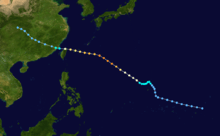Typhoon Billie (1976)
| Category 4 (Saffir–Simpson scale) | |
 Typhoon Billie on August 7. 1976 | |
| Formed | August 3, 1976 |
|---|---|
| Dissipated | August 12, 1976 |
| Highest winds |
1-minute sustained: 230 km/h (145 mph) |
| Lowest pressure | 915 hPa (mbar); 27.02 inHg |
| Fatalities | 48 direct |
| Damage | $2.6 million (1976 USD) |
| Areas affected | Japan, Taiwan, Eastern China |
| Part of the 1976 Pacific typhoon season | |
Typhoon Billie was an early August Category 4 typhoon that left 48 people dead and eight others missing (mostly at sea) and left $2.6 million (1976 USD, $8.9 million 2005 USD) in damage in Taiwan and eastern China after its 3449 km track across the far western Pacific.[1]
Meteorological history

A tropical disturbance 180 miles (289 km) northeast of Ponape formed on July 31 and moved westward as it continued to strengthen, becoming Tropical Depression 13W on August 3. Interacting with a subtropical ridge to the north, the tropical depression turned sharply northeast and passed over Saipan before strengthening into Tropical Storm Billie.
Driven by a high pressure system and a trough, Billie then turned to the southwest and then westward and intensified into a typhoon on August 5. On August 7, Typhoon Billie underwent rapid intensification, reaching a maximum intensity of 140 mph (125 knots).
By August 12, the tropical cyclone had encountered wind shear which weakened the storm before it hit Taiwan as a Category 1 typhoon and China as a tropical storm. Billie then dissipated after landfall.
Impact
Billie skirted the Ryūkyū Islands before making landfall in Taiwan and again in eastern China, producing huge waves that drowned 41 fishermen and swimmers along the coast of Japan. A JTWC weather station in Miyakojima reported a barometric pressure of 962 millibars and winds of 51 mph (82 km/h). In Ishigakijima, a weather station reported winds of 109 mph (176 km/h) and a barometric pressure of 952 millibars.[2]
Billie's second landfall was south of Taipei, Taiwan where a weather station reported 81 mph (130 km/h) winds. However, at the Taipei International Airport, the winds were at 40 mph (65 km/h) with gusts up to 75 mph (120 km/h). Billie's impact in Taiwan was destructive as the storm sank three ships and damaged several others and killed seven people, leaving eight others missing, injured 24 and left $2.6 million (1976 USD, $8.9 million 2005 USD) in damage.[2]
The third and final landfall was in eastern China as a tropical storm which brought 70 mph (113 km/h) winds and heavy rain but there were no reports of deaths or damage reported.[2] The name Billie was not retired after the 1976 Pacific typhoon season.